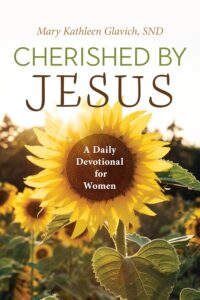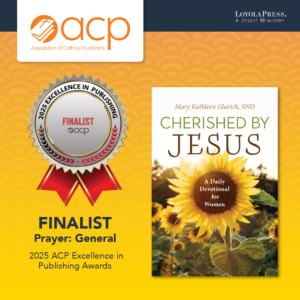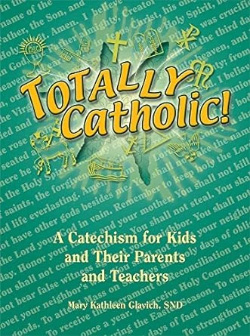How to Be Happy

To give more credibility and power to a saying or passage, someone will attribute it to a famous person. For example, Abraham Lincoln would be surprised at the number of things he allegedly said. Recently on Facebook a talk appeared that was attributed to Pope Francis. Now this pope has said a number of beautiful things, but this talk wasn’t one of them. After a little research, a man discovered that the source was a loose English translation of “Palco de vida” attributed to the Portuguese poet Fernando Pessoa (1888-1935).
Regardless of the incorrect attribution, the passage contains sound, practical advice. I thought it was worth passing on to you….
“You can have flaws, be anxious and even be angry, but do not forget that your life is the greatest enterprise in the world. Only you can stop it from failing.
You are appreciated, admired and loved by so many. Remember that being happy is not about having a sky without storm, a road without accidents, a job without effort, a relationship without disappointments.
“To be happy means to find strength in forgiveness, hope in battles, security in fear, love in discord. It’s not only to enjoy the smile, but also to reflect on the sadness. It’s not just about celebrating success, it’s about learning from failures. It’s not just about feeling happy with applause, it’s about being happy in anonymous. Being happy is not a fatality of fate, but an achievement for those who can travel within themselves.

“To be happy is to stop feeling like a victim and become the author of your own fate. It’s walking through deserts, but being able to find an oasis deep in the soul. Is thanking God every morning for the miracle of life. Being happy is not being afraid of your feelings and being able to talk about yourself. Have the courage to hear a “no” and find confidence in criticism, even when it’s unwarranted. It’s kissing your children, cuddling your parents, having poetic moments with your friends, even when they hurt us.
“Being happy is letting the creature that lives in each of us live, free, joyful and simple. You have the maturity to be able to say: “I’ve made mistakes.” It’s having the courage to say I’m sorry. It’s having the sense to say “I need you.” Is having the ability to say “I love you.” May your life become a garden of opportunities for happiness… that in spring he may be a lover of joy and in winter a lover of wisdom.
“And when you make a mistake, start over. Because only then will you be in love with life. You’ll discover that being happy isn’t having a perfect life. But use tears to irrigate tolerance. Use your defeats to train your patience.
“Use your mistakes with the serenity of the sculptor. Use pain to tune into pleasure. Use obstacles to open the windows of intelligence. Never give up … Above all never give up on the people that love you. Never give up on being happy, because life is an incredible spectacle.”
• Which piece of advice speaks to you? What advice can you add?
Why Mary Is the Seat of Wisdom
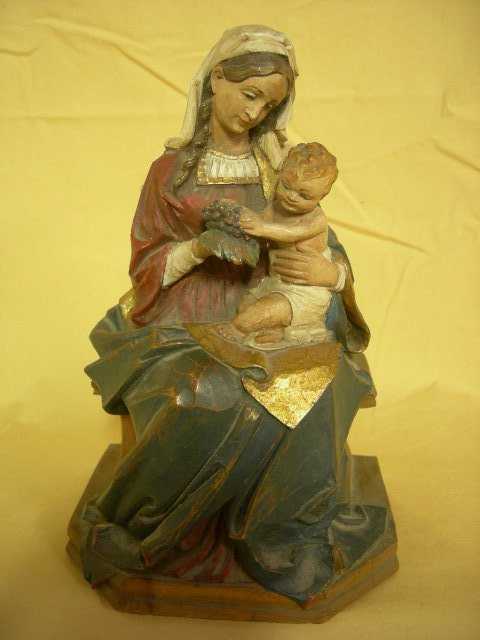
Today, June 8, is the feast day of Mary, Seat of Wisdom. She was known by this title since the 11th century. In the Litany of Loreto we invoke Our Lady by this name. Images of Mary, Seat of Wisdom, depict her holding Jesus on her lap and sometimes she is seated on a throne. Jesus is known as wisdom, and Paul calls him this in 1 Cor. 1:24… “Christ is the power of God and the wisdom of God.” Therefore when Jesus is held by Mary, her lap becomes his seat. She is the seat, or throne, of wisdom.
On another level, Mary is the seat of wisdom, meaning the gift of the Holy Spirit. Wisdom resides in her. She was wise to agree to God’s plan of salvation. She was wise to ponder God’s working in her life like the words of the shepherds (Luke2:19). She was wise to prompt Jesus to change water into wine. After the Holy Spirit descended on her at Pentecost, she became wiser still. I imagine the first disciples often consulted her and learned from her, especially John.
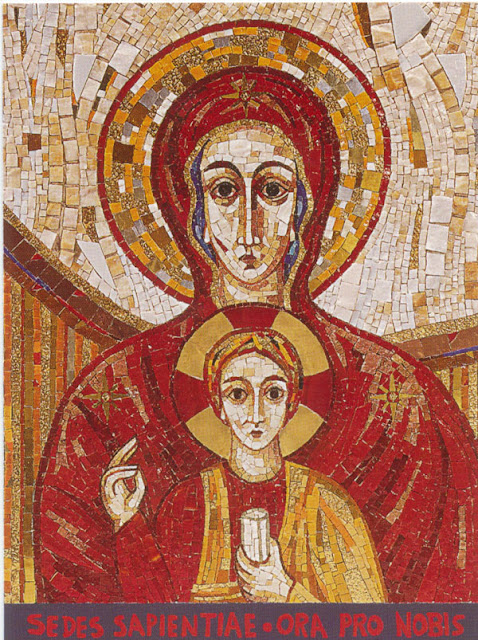
In 2002 Saint Pope John Paul II commissioned Slovenian (Yay!) artist Marko Rupnik, S.J., to make a mosaic of Mary, Seat of Wisdom (Sedes Sapientiae) to be given to university students worldwide. It was intended to encourage them to maintain Christianity at these places of higher learning. (You can learn more about this renowned creator of mosaics on the Internet and youTube.)
My yearly reflection book Heart to Heart with Mary continues to amaze me. How many times people have told me how a reading for the day was particularly apt for them. Following is the selection from this book for June 8. It may speak to you.
A Wise Teacher
Mary, Seat of Wisdom
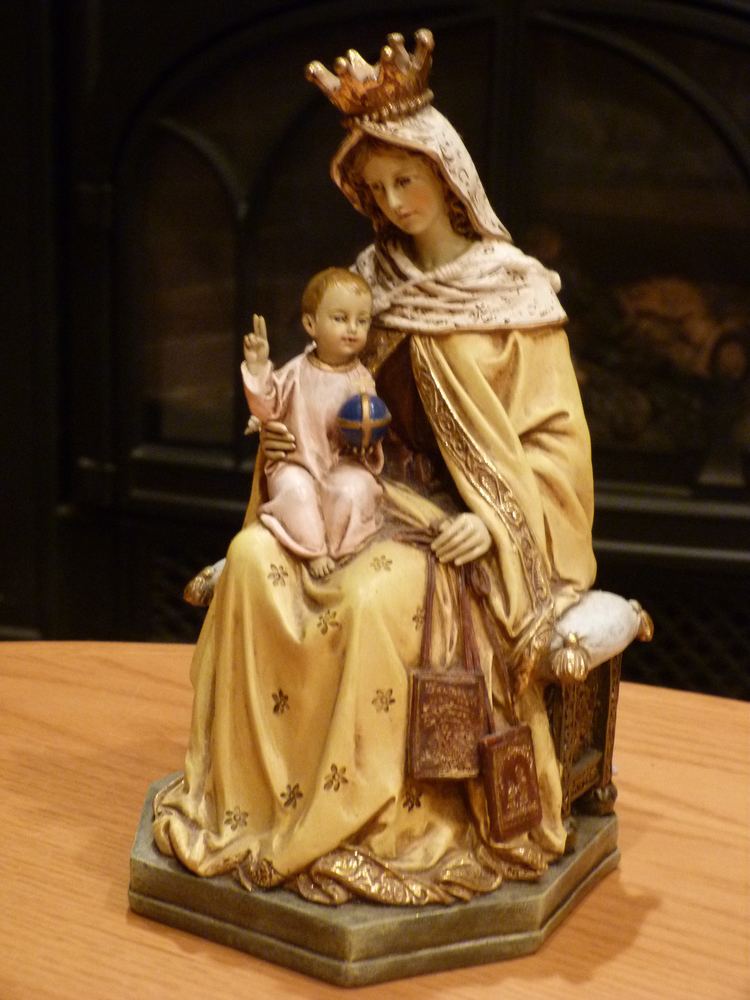
June 8
My child, in case the title of mine Seat of Wisdom puzzles you, let me explain. I was the site where the Son of God, who is wisdom and truth, grew for nine months. Later, my lap was literally his seat as I fed him, taught him to speak, and put on his little sandals. Another meaning of this title is that I am a wise virgin. I am wise in the ways of the Lord. I know about God, what he does, and what pleases him.
You prize your education through which you plumb the secrets of the secular world. I invite you to sit at my feet and learn from me a far more important and life-giving knowledge. Just as I taught Jesus, I will teach you how to be the best human being you can be. Study my life and my virtues. Let me steer you away from false teachers whose instruction would lead you astray and ultimately harm you. When you take me as your teacher, you too will become wise. You will see things as God sees them.
Talk to Mary about what you would like her to teach you.
Musings on the Cana Wedding Miracle
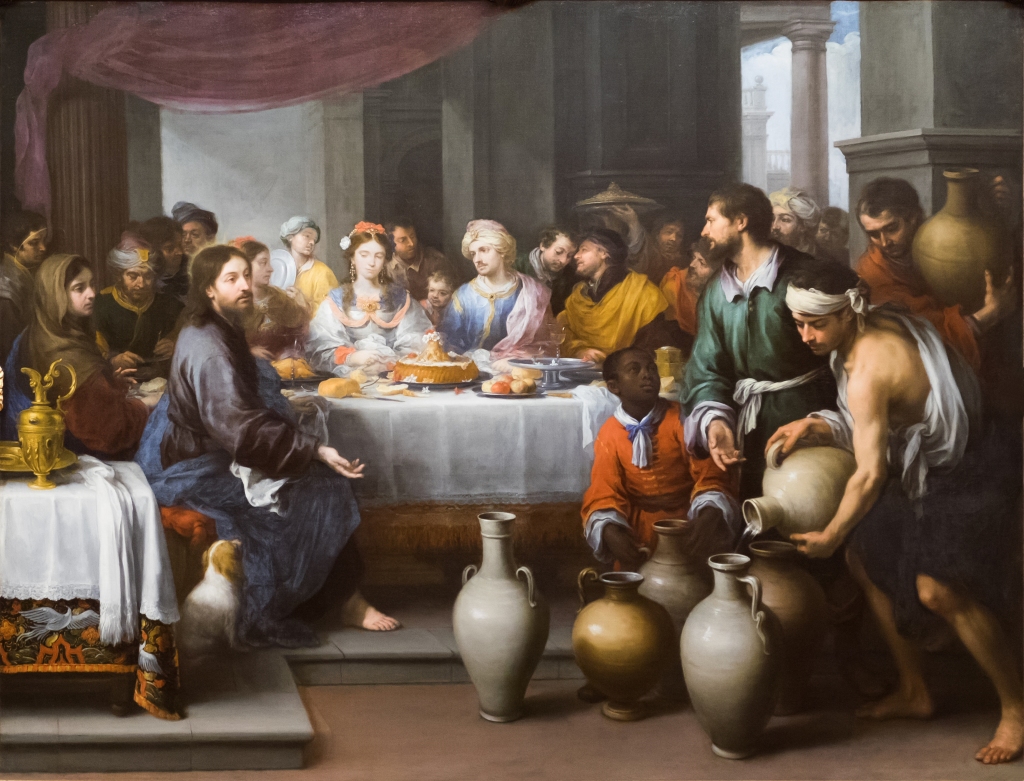
The first miracle Jesus worked as presented in John’s Gospel overflows with lessons. He wasn’t planning to begin his public life that day, but Jesus was open to God’s prompting him through his mother Mary. Sometimes it’s good to pay attention to others’ suggestions.
The setting of the miracle itself is significant. The fact that Jesus was at a wedding shows that he had a social life. He probably enjoyed celebrating the marriage of the bride and groom, hobnobbing with his relatives and neighbors, and feasting on the sumptuous meal. I imagine he danced with the other men, like I witnessed men doing at a wedding in Arabia.
Of course, this miracle illustrates the sway Mary has over her divine Son. As the story goes, the wine ran out at the wedding. (Someone surmised that this was because Jesus was accompanied by the twelve apostles!) Mary, who perhaps was helping with the refreshments, noticed the crisis. She understood how embarrassed the young couple and their parents would be when their guests asked the waiters to refill their glasses and there wasn’t any wine left. From that day on their memories of the wedding would be painful.
Confidently, Mary approached her Son and simply murmured, “They have no wine.” At first Jesus hesitated. He said something like, “So what? It’s none of our business.” He pointed out that it wasn’t the time for him to act like the Messiah. But then the young Jewish man responded to his mother’s implied plea. We can count on Mary to intercede for us when we are in need.
Mary believed that Jesus would help. Her faith was such that she ordered the waiters, “Do whatever he tells you.” (This has been called “Mary’s commandment.” We too are to do whatever Jesus says.)
There were six stone water jars there. Jesus proceeded to provide the largest six-pack ever. He said to the waiters, “Fill these to the brim.” Even though the waiters must have wondered what a carpenter could do about supplying wine, they obeyed Mary and did as Jesus said. She must have been a powerful woman in the community.
Then, as the poet Richard Crashaw wrote, “The conscious waters saw their Master and blushed.” Jesus told the waiters to take some of this new wine to the head steward. (Imagine the shock on the waiters’ faces when they drew wine from the water jars.) After tasting the wine, the steward said to the bridegroom, “Everyone serves the good wine first, and the inferior wine after the guests are drunk. But you have kept the best wine until now.” No doubt the bridegroom was puzzled.
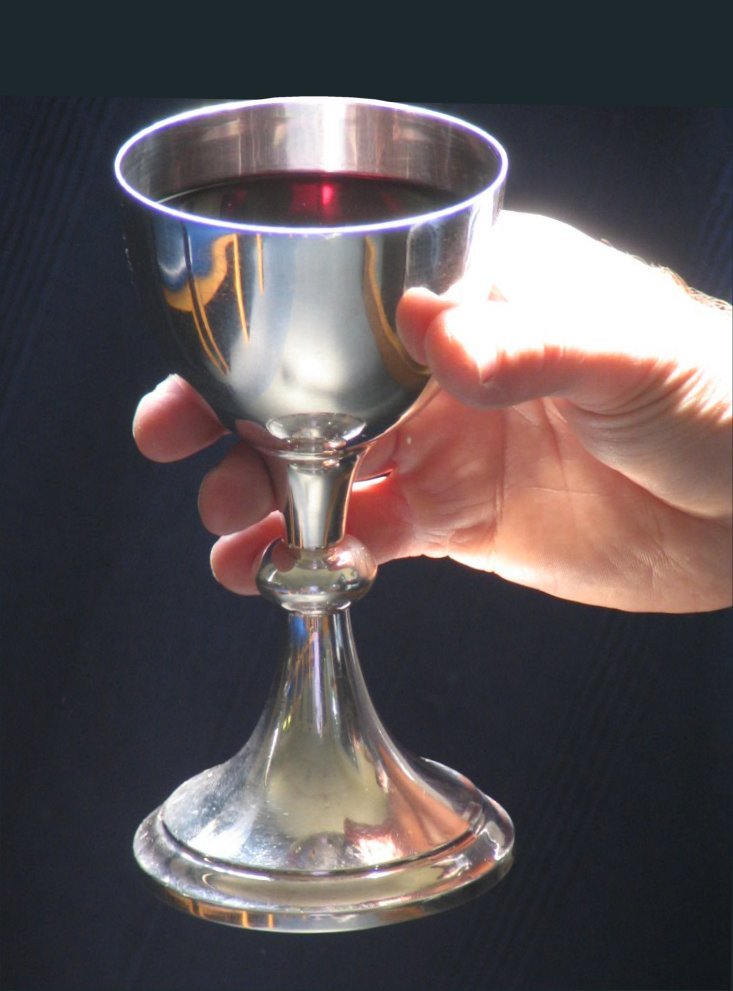
Not only was the wine excellent; it was abundant. Each jar held twenty or thirty gallons, which meant that Jesus provided about 150 gallons of wine—more than enough to go around for the days the wedding lasted. (Jewish weddings could take seven days.) God often surprises us by blessing us with more than we would ever need or even dream of. Witness the Eucharist where Jesus again provides miraculous wine over and over throughout the world.
The plentiful wine in Cana was a sign of God’s kingdom where “the mountains shall drip sweet wine, and all the hills shall flow with it” (Amos 9:13).
St. John does not say that Mary took credit for jumpstarting this first miracle of Jesus. She probably just winked at her Son and smiled sweetly. Then she and Jesus enjoyed a fresh cup of wine.
A further thought: St. Augustine noted, ““We take for granted the slow miracle whereby water in the irrigation of a vineyard becomes wine. It is only when Christ turns water into wine, in a quick motion, as it were, that we stand amazed.”
• When has God given you more that you ever hoped for?
Saint Hildegard of Bingen, an Extraordinary Woman
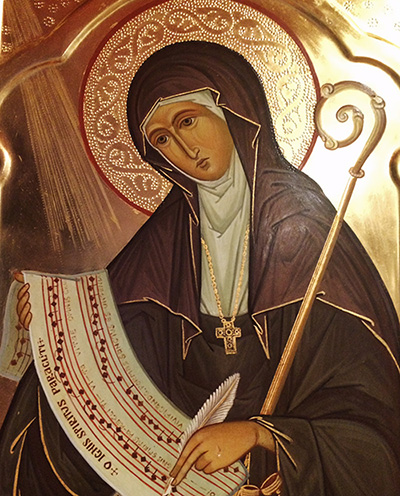
Recently I edited an article on Saint Hildegard and learned much about this remarkable woman. Although she was born in 1098, it took 900 years before Pope Benedict XVI named her a saint in an “equivalent canonization” in 2012 and then shortly after, she was given the title doctor of the church. A true polymath, Hildegard was adept at writing books and letters, preaching, composing music, poetry, and a play, giving wise counsel, and prescribing and practicing medicine. All this while she served as an abbess at two Benedictine monasteries.

Most interesting today, Hildegard is a model for women standing firm in the face of patriarchy and seeking a voice in the Church. Her theme of respect for and love of creation that receives its viriditas (greenness) from God makes her a relevant saint.
Born the tenth child of wealthy landowners in Germany, Hildegard was favored with visions—allegedly from the age of three! She experienced these as light. When she was six years old, her parents dedicated her to God. Jutta, a noblewoman about six years older, became her guide and continued to be one after the two joined a Benedictine monastery.
Around 1140, Hildegard received a fiery vision accompanied by infused knowledge of Scripture and the faith. The flame ordered her to speak and write of these mysteries. She produced Scivias, which led to Pope Eugene III authorizing her to write her visions and to speak in public, something women had not be able to do in part because St. Paul prohibited them from teaching (1 Tim. 2:9). Hildegard traveled from town to town preaching. Curiously, another abbess wrote Hildegard a letter admonishing her for allowing her nuns to wear their hair down and be adorned with jewels!
When Frederick I of the Holy Roman Empire intended to name and install a new pope, Hildegard wrote vehement letters to him discouraging this. She was also not afraid to rebuke the clergy for failing to live a moral life as witness to the laity. To combat the heretical Cathars who believed that the material world was evil, she wrote emphasizing the goodness of creation. Some of her theology about the Trinity and the soul states what Aquinas taught centuries after she lived.
Hildegard’s original monastery was next to the monks’ monastery. When a vision told her to move to a larger house, the abbot tried to keep her monastery dependent on him. She went over his head and appealed to the archbishop. Still the abbot would not free her . . . until a paralyzing illness made it impossible for him to move her. Then Hildegard staunchly struggled to retain the sisters’ possessions and dowries. And in 1155 the nuns received all their property. Fifteen years after founding this new monastery at St. Rupert, Hildegard founded another one in Eibingen.
Among Hildegard’s works are the play Order of Virtues, the Book of Life’s Merits, and the Book of Divine Works. Reading this mystic’s writings requires determination, patience, and perseverance. They are not easy to understand.
• How familiar are you with Saint Hildegard?
Intriguing Facts about the Blessed Virgin Mary
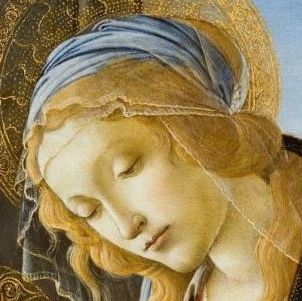
As I worked on my latest book about Mary, my research uncovered some interesting facts. Hope you enjoy reading them:
• This is the fact I found most interesting: During the Middle Ages Europe’s crops were plagued by pests. After farmers prayed to Mary, beetles appeared that preserved the crops. These beetles were dubbed ladybugs in honor of Our Lady! Their red color was said to resemble her cloak, and their seven black dots were thought to represent her seven sorrows.

• The Marianum in Rome, a pontifical institute for the study of Mariology, offers a master’s degree and a doctorate in the field. Its library holds more than 85,000 books on Mary!
• The Protoevangelium of James (Gospel of James) from about 150 AD is apocryphal, not considered divinely inspired. The Church, however, drew from it the traditional names for Mary’s parents. One of its stories also gave rise to the November 21 celebration of the Presentation of Mary in the Temple at age three.
• The flagship Christopher Columbus sailed on to America was the Santa Maria. Its full name was Saint Mary of the Immaculate Conception. Missionary and explorer Jacques Marquette, S.J., who discovered the Mississippi River, named it River of the Immaculate Conception. (Maryland was named by King Charles I of England for his wife, Queen Henrietta Maria.)
• The mystics Saint Bridget of Sweden, Venerable Mary of Agreda, and Blessed Anne Catherine Emmerich supply details about Mary that allegedly were revealed to them in visions. Some of these details are contradictory, for example, how long after Jesus’ death Mary was assumed into heaven.
• In 2020, Pope Francis added three titles to the Litany of Loreto: Mother of Mercy, Mother of Hope, and Solace of Migrants.
• The prayer We Fly to Thy Patronage (Sub Tuum Praesidium) is the oldest Marian prayer.
• Under a variety of titles Mary is the patroness of all fifty states in the United States. See Elizabeth Scalia’s Litany to the Immaculate Conception, Patroness of the United States of America at https://bit.ly/3irBZAY.
• Arguably the most well-known Marian hymn is “O Sanctissima,” which was first published in 1792 and thought to have originated with Sicilian seamen invoking Mary’s protection each evening.
• Saint Padre Pio observed, “In times of darkness, holding the rosary beads is like holding your Blessed Mother’s hand.”
• In the eleventh century Lady Godiva bequeathed her paternoster of precious gems to a monastery. This paternoster, a forerunner of the rosary, was a circle of beads on which Our Fathers were prayed. Pater noster is Latin for “our father.”
• No doubt the 322-foot statue Mother of All Asia Tower of Peace in the Philippines is the tallest one of Mary.

• Notre Dame is one of around eighty cathedrals in Mary’s honor built in France from 1140 to 1280.
• The largest Christian church in the world is also named for Mary: the Basilica of Our Lady of Peace in Yamoussoukro, Côte d’ Ivoire (Ivory Coast), in Africa. This basilica is larger than St. Peter’s Basilica in Rome.
My book was published on May 13, Feast of Our Lady of Fatima!



